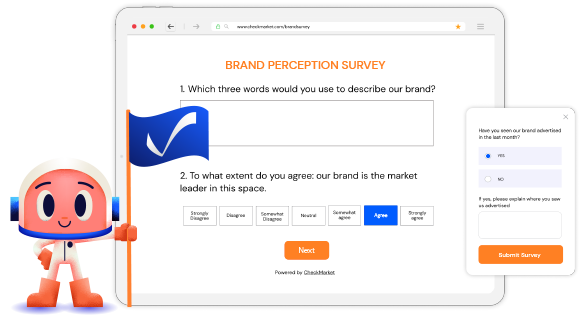Surveys are simple yet powerful tools that can provide valuable insight into your brand.
What is your business doing right? Where are pain points that have room for improvement? How satisfied are your employees? What do your customers think about your brand?
Brand perception in the eyes of your customers is a critical piece of your marketing equation. While engineered customer personas certainly hold merit as you’re planning the next marketing campaign, the best way to measure brand perception is straight from the customer.
What is a Brand Perception Survey?
The purpose of a brand perception survey is to understand how your customers, prospects, stakeholders, and employees perceive your brand.
Think of some popular brands and the immediate association you have with them. For example, when you think of TikTok, you probably think of a young audience, short videos, and dancing.
But brand perception goes even deeper. Do customers trust your brand, or did they have a bad experience that makes them immediately feel a negative reaction whenever they think about your company? Do prospects already know what kind of goods or services you offer? Does your business have a memorable name? A recognizable logo?
In 2019, Doritos demonstrated just how confident it was in its brand perception and identity when it launched an “anti-ad” campaign with no logo and no brand name in order to appeal to a Gen Z audience. The company claimed the iconic triangle shape of their chips and branded colors were enough to still be recognizable even without traditional advertising. And they were right.
But Doritos probably wouldn’t have taken that bold leap without plenty of outreach and surveys to gauge their customers’ perception of their brand first.
How Do You Test Brand Perception?
The concept of brand perception can be tricky to nail down, since a precise measurement is impossible to take, and opinions of your brand will vary from person to person.
Companies rely on brand perception surveys to achieve three primary outcomes:
- To understand how past, present, and future marketing campaigns impacted (or need to impact) overall brand perception
- To identify and minimize the gap between qualities the brand wants to portray, and how the customer actually feels about the brand.
- To find opportunities for improvement based on customer experiences and perceptions.
In order to get a somewhat accurate pulse of consumer perception of your brand, your survey should focus on these four factors:
1. Cognitive
Cognitive questions uncover concepts and associations that a customer connects with your brand. The Doritos example using a triangle and branded colors is a prime illustration of cognitive brand perception.
Open-ended questions and multiple-choice word lists can be especially helpful to determine what connections are being made with your brand.
2. Emotional
These types of questions will help you to gauge the emotional connection a customer feels with your brand. Measuring your customers’ emotions can be a subtle way of analyzing their brand loyalty and trust in your company as well.
Scale questions, such as “rank on a scale from 1-10,” and open-ended questions often provide the best insights on how customers feel about your brand, and whether that pulls them closer to your brand or pushes them farther away.
3. Descriptive
What kind of language do customers use when describing your brand to others? Is it positive, negative, or neutral?
Focusing on the language and descriptions your customers are using can help future marketing campaigns to either build up and reinforce positive perceptions using the same type of language, or try to redirect your customers’ word choice and perception by presenting alternative vocabulary.
Open-ended questions are usually best for this category, so customers can tell you exactly what words they’re using rather than selecting from predetermined choices.
4. Action-Based Experiences
Asking your customers about their positive and negative experiences is particularly effective when it comes to learning more about the performance of your customer service team and the functionality of your ecommerce shopping experience.
While multiple choice and scale questions are a quick way to analyze overall satisfaction in your company’s services, it’s a good idea to have at least one open-ended question at the end of the survey where customers can elaborate on why they gave the score they did.
After all, a brand perception survey isn’t going to be helpful if you don’t know the reason a customer is upset about their experience.
13 Brand Perception Survey Questions You Should Be Asking
You have several options when it comes to determining the best audience for a brand perception survey.
If you’re interested in obtaining data on a segmented portion of your audience, such as first-time customers or prospects who have heard of your brand but not committed to a purchase yet, then you can limit your questions to a specifically targeted demographic.
But if your goal is to get an all-encompassing view of your brand as a whole, you can send tailored brand perception surveys out to employees, vendors, business partners, stakeholders, new customers, long-term repeat customers, former customers, leads, focus groups, and anyone else you feel might be able to offer valuable insight.
Brand perception survey questions to ask customers:
- Are you familiar with our products/services? If so, how did you discover our brand?
- How would you describe our products to a friend?
- When you think of our brand, what comes to mind?
- If you had to describe our brand in three words, what would they be?
- How likely are you to recommend our brand to your friends?
- How would you describe your last experience with our brand?
Brand perception survey questions to ask employees:
- What did you know about the company before you applied for a position here?
- What factors made you want to work for us?
- What makes you happy about working here?
- If you could change one thing about the company, what would it be and why?
Brand perception survey questions to ask prospects and leads:
- How did you become aware of our brand and the products/services we offer?
- What have you heard (both positive and negative) about our brand?
- What was your first impression when you interacted with our company for the first time?

How Do You Write a Brand Perception Survey?
The good news – you don’t have start from scratch and waste time staring at the ominous blank page, wondering where to begin. Survey templates are an accessible asset available to help you, offering brand survey examples you can build from.
But before you dive into the templates, start by taking a step-by-step approach and developing a strategy.
First, identify the goals you want to achieve with your brand perception survey. What is the ideal response rate you’re looking for? How will your results impact your marketing goals? What factors about your brand are you specifically hoping to identify (i.e. customer service, brand recognition, online shopping experience)?
Next, consider your audience. Are you sending one survey out to a segmented population? Or will you need to create several difference versions of your brand perception survey for employees, customers, leads, et cetera?
Then, create your list of questions that fit the needs of both your survey objectives and the audience you’re targeting.
Some factors you should be mindful of when creating your survey:
- Time: If you want to maintain an average-to-high response rate, try to keep your survey relatively short. People are less likely to complete the survey if it takes too long.
- Complexity: Simple is better when it comes to surveys. Don’t overwhelm your audience with complicated instructions and questions that don’t make sense.
- Anonymity: Some respondents, especially if you’re sending out surveys for employees and stakeholders, may not complete the survey if they’re concerned about negative consequences for less-than-favorable answers.
- Question Types: Open-ended questions are a fantastic way to gain valuable insight in your customers’ own words, but they take more time and effort to answer. Vary the types of questions you’re asking in the survey to keep your respondents engaged.
When done correctly with a targeted, strategic approach, brand perception surveys can be a powerful tool to help your business represent the qualities you value.
Are you ready to create your brand perception survey? Sign up for FREE and get started!



Laisser un commentaire